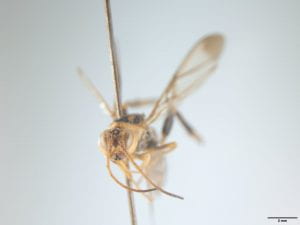This week’s wasp is the ibaliid wasp species Ibalia anceps! This species was first described by the American entomologist Thomas Say in the year 1824.
 Figure 1: Ibalia anceps female, lateral habitus
Figure 1: Ibalia anceps female, lateral habitus
 Figure 2: Ibalia anceps female, dorsal habitus
Figure 2: Ibalia anceps female, dorsal habitus
 Figure 3: Ibalia anceps female, anterior view
Figure 3: Ibalia anceps female, anterior view
 Figure 4: Ibalia anceps female, face
Figure 4: Ibalia anceps female, face
Taxonomy: This species is a member of the superfamily Cynipoidea and the family Ibaliidae. The superfamily Cynipoidea also includes the families Cynipidae (gall wasps), Figitidae, Liopteridae, and Austrocynipidae. The family Ibaliidae contains 20 living species, which are classified in three genera. There are two species of the family, both in the genus Ibalia, in the eastern United States: Ibalia anceps Say, 1824 and Ibalia leucospoides (Hochenwarth, 1785).
Identification: This species is recognized as a member of the superfamily Cynipoidea primarily by the wing venation, as cynipoids have a distinct large, somewhat-triangluar radial cell on the leading edge of the forewing, and generally complex venation on the rest of the forewing. Many cynipoids also have a laterally flattened metasoma. Ibaliids are also the largest members of Cynipoidea – most cynipoids are tiny and only a few millimeters long! This species is recognized as a member of the family Ibaliidae by the long, thin radial cell of the forewing (see Figure 5 below), which is many times longer than it is wide, and by the shape of the metasoma, which is very long, very flat, and distinctly blade-like. Ibalia is the only genus of the family in North America. The two eastern United States species of Ibalia are very easy to tell apart, as Ibalia leucospoides has a black head and mesosoma with a deep red metasoma, and Ibalia anceps is entirely yellow and brown.
 Figure 5: Ibalia anceps forewing, indicating the radial cell (in red)
Figure 5: Ibalia anceps forewing, indicating the radial cell (in red)
Natural History: Ibaliid wasps are rarely encountered. They are all parasitoids of horntail sawflies of the family Siricidae. Ibalia anceps is a parasitoid of the siricid genus Tremex, which is fairly common throughout North America. Not much else is currently known.
View This Species On:
BugGuide: https://bugguide.net/node/view/63912
iNaturalist: https://www.inaturalist.org/taxa/470470-Ibalia-anceps
References:
- Aguiar, A. P., Deans, A. R., Engel, M. S., Forshage, M., Huber, J. T., Jennings, J. T., … & Miko, I. (2013). Order Hymenoptera. In: Zhang, Z.-Q.(Ed.) Animal Biodiversity: An Outline of Higher-level Classification and Survey of Taxonomic Richness (Addenda 2013). Zootaxa, 3703(1), 51-62.
- Goulet, H., Huber, J. T. (1993). Hymenoptera of the world: An identification guide to families. Ottawa: Research Branch Agriculture Canada.
Leave a Reply